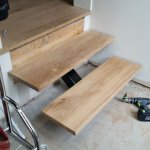when I had to deal with some squeaking that occurred after I'd replaced some floorboards, I found a number of tools extremely helpful.
Selecting the correct, large tool - claw hammer, tugboat propeller wrench, axe, writ of habeus corpus - and waving it around in the air for a while worked fine. Client soon stopped squeaking and paid up. If you're not worried about repeat work, it might be a useful addition to your armoury.
If that fails, blood spills will totally disguise any lingering wine stains.
More seriously, how big a problem would just leaving it be?
Your steps will not stay sawmill-fresh white for long unless you store them in the dark and use a uv-barrier water-based acrylic glaze of some sort. The beauty of wood is largely in the way it ages and picks up character and it's going to do that no matter what. The problem is if it does it unevenly.
Red wines, contain tannin, oak contains tannin - it's going to react with all sorts of stuff sooner or later whether liquid-borne or simply in the atmosphere. It's like an exposed but undeveloped film, imbued with a latent image which, once the proper chemicals are applied, becomes a real, physical image.
As time passes, a wine stain is going to fade, though unevenly at first but it may lay in wait to darken itself off again if it comes into contact with spilled pickles or if the client tries waxing the step with wire wool and detergent instead of soap. I'd say that it would be best to re-apply red wine to the whole step area, let it dry, wash it off again and THEN embark on any bleaching process. That way the wood will not be potentiated unevenly towards further darkening should another mishap come tripping along.
Just musing. Others may have better experience of these matters.
Carpet tiles? Deep-red lampshade?


